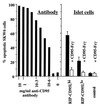Transgenic expression of CD95 ligand on islet beta cells induces a granulocytic infiltration but does not confer immune privilege upon islet allografts
- PMID: 9108084
- PMCID: PMC20547
- DOI: 10.1073/pnas.94.8.3943
Transgenic expression of CD95 ligand on islet beta cells induces a granulocytic infiltration but does not confer immune privilege upon islet allografts
Abstract
Binding of CD95 (Fas/APO-1) by its ligand (CD95L) commonly induces apoptosis. Apoptosis of activated T cells, induced by CD95L expressed in the rodent testis, has been proposed to be the mechanism of immune privilege [Bellgrau, D., Gold, D., Selawry, H., Moore, J., Franzusoff, A. & Duke, R. C. (1995) Nature (London) 377, 630-632]. To test whether CD95L could protect pancreatic islet grafts from rejection, we made transgenic mice expressing murine CD95L on their islet beta cells and transplanted fetal pancreata under the kidney capsules of allogeneic animals. Expression of CD95L failed to protect the grafts from rejection. However, transgenic mice developed a granulocytic infiltration in their pancreata. These results demonstrate a pro-inflammatory function of CD95L and suggest that expression of CD95L may not be sufficient to protect organ allografts.
Figures



Comment in
-
Fas-ligand: privilege and peril.Proc Natl Acad Sci U S A. 1997 Jun 10;94(12):5986-90. doi: 10.1073/pnas.94.12.5986. Proc Natl Acad Sci U S A. 1997. PMID: 9177153 Free PMC article. Review. No abstract available.
References
-
- Bellgrau D, Gold D, Selawry H, Moore J, Franzusoff A, Duke R C. Nature (London) 1995;377:630–632. - PubMed
-
- Griffith T S, Brunner T, Fletcher S M, Green D R, Ferguson T A. Science. 1995;270:1189–1192. - PubMed
-
- Barker C F, Billingham R E. Adv Immunol. 1977;25:1–54. - PubMed
-
- Nagata S, Golstein P. Science. 1995;267:1449–1456. - PubMed
-
- Klas C, Debatin K M, Jonker R R, Krammer P H. Int Immunol. 1993;5:625–630. - PubMed
Publication types
MeSH terms
Substances
LinkOut - more resources
Full Text Sources
Other Literature Sources
Medical
Molecular Biology Databases
Research Materials
Miscellaneous

